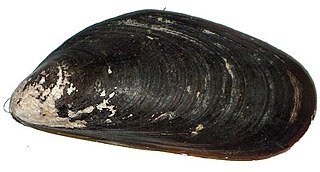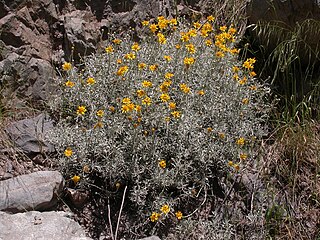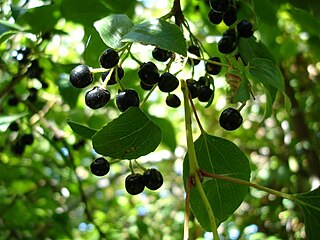Cypress is a common name for various coniferous trees or shrubs of northern temperate regions that belong to the family Cupressaceae. The word cypress is derived from Old French cipres, which was imported from Latin cypressus, the latinisation of the Greek κυπάρισσος (kyparissos). Cypress trees are a large classification of conifers, encompassing the trees and shrubs from the cypress family (Cupressaceae) and many others with the word cypress in their common name. Many cypress trees have needle-like, evergreen foliage and acorn-like seed cones.

Puya is a genus of the botanical family Bromeliaceae. It is the sole genus of the subfamily Puyoideae, and is composed of 226 species. These terrestrial plants are native to the Andes Mountains of South America and southern Central America. Many of the species are monocarpic, with the parent plant dying after one flower and seed production event.

Knowltonia is a genus of flowering plants in the family Ranunculaceae. There are 25 species native to South Africa and Latin America. The juice from the stem of many of the species in the genus is a powerful vesicant.

Austrocedrus is a genus of conifer belonging to the cypress family (Cupressaceae). It has only one species, Austrocedrus chilensis, native to the Valdivian temperate rain forests and the adjacent drier steppe-forests of central-southern Chile and western Argentina from 33°S to 44°S latitude. It is known in its native area as ciprés de la cordillera or cordilleran cypress, and elsewhere by the scientific name as Austrocedrus, or sometimes as Chilean incense-cedar or Chilean cedar. The generic name means "southern cedar".

Jubaea is a genus of palms with one species, Jubaea chilensis, commonly known in English as the Chilean wine palm or Chile cocopalm, and palma chilena in Spanish. It is native to southwestern South America and is endemic to a small area of central Chile between 32°S and 35°S in southern Coquimbo, Valparaíso, Santiago, O'Higgins, and northern Maule regions.
The Jardín Botánico Chagual is a 33.9-hectare Chilean botanical garden in the process of development, focusing on the preservation of plants native to the Mediterranean climatic zone of Chile. It forms part of the Sistema Nacional de Áreas Protegidas del Estado and of the Botanic Gardens Conservation International (BGCI). It is meant to complement the collections of native plants in the national botanical gardens of Viña del Mar and Valdivia.

Carpobrotus chilensis is a species of succulent plant known by the common name sea fig. It grows on coastal sand dunes and bluffs and is used as an ornamental plant, and it is also edible. However, along with its even more troublesome cousin, C. edulis, it has invaded sections of the California coast at the expense of native vegetation, and is subject to control efforts.

The native flora of Chile is characterized by a higher degree of endemism and relatively fewer species compared to the flora of other countries of South America. A classification of this flora necessitates its division into at least three general zones: the desert provinces of the north, Central Chile, and the humid regions of the south.

The Chilean mussel or Chilean blue mussel is a species of blue mussel native to the coasts of Chile from Biobío Region to Cape Horn. Today genomic evidence confirmed that the native Chilean blue mussel is genetically distinct from the Northern Hemisphere M. edulis, M. galloprovincialis and M. trossulus and also genetically different from Mytilus platensis,the other species of smooth shelled mussel from South America.

Senecio chilensis is a species of the genus Senecio, family Asteraceae and one of the many species of Senecio native to Chile.

The Chilean Matorral (NT1201) is a terrestrial ecoregion of central Chile, located on the west coast of South America. It is in the Mediterranean forests, woodlands, and scrub biome, part of the Neotropical realm.

The dredge oyster, Bluff oyster or Chilean oyster, is also known in Chile as ostra verde, is a species of bivalve mollusc in the family Ostreidae.

Aristotelia chilensis, known as maqui or Chilean wineberry, is a tree species in the Elaeocarpaceae family native to South America in the Valdivian temperate forests of Chile and adjacent regions of southern Argentina. Limited numbers of these trees are cultivated in gardens for their small edible fruits. Wild-harvested fruits are commercially marketed.
Evocoa is a monotypic genus of flies containing the single species Evocoa chilensis. It is the only genus in the family Evocoidae.

Traubia is a genus of Chilean plants in the Amaryllis family. Only one species is recognized, Traubia modesta, native to northern and central Chile.

Eriosyce chilensis or "Chilenito" is a critically endangered species of cactus from Chile. Found on the coast between Coquimbo and Valparaiso, the plant is one of the world's 100 most threatened species according to the IUCN. Its rarity is primarily due to its small native habitat range and illegal overcollection for the ornamental cactus trade. The cactus has two known varieties, which are similar except that var. chilensis produces red flowers while var. albidiflora produces yellow flowers.

Libertia chilensis, synonym Libertia formosa, called the New Zealand satin flower, snowy mermaid, or Chilean-iris, is a species of flowering plant in the iris family, Iridaceae, native to the Juan Fernández Islands, central and southern Chile, and southern Argentina. It can also be found growing wild in the San Francisco Bay Area and San Bernardino County in California, where it is an introduced species. A rhizomatous evergreen perennial, it has gained the Royal Horticultural Society's Award of Garden Merit.

Pintoa is a monotypic genus of flowering plants belonging to the family Zygophyllaceae. It only contains one known species, Pintoa chilensisGay














